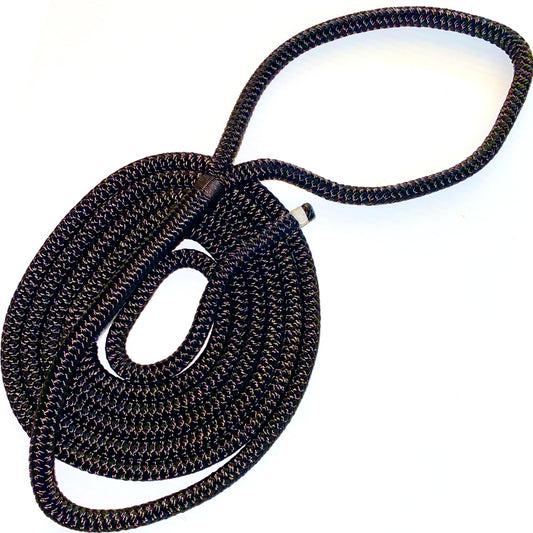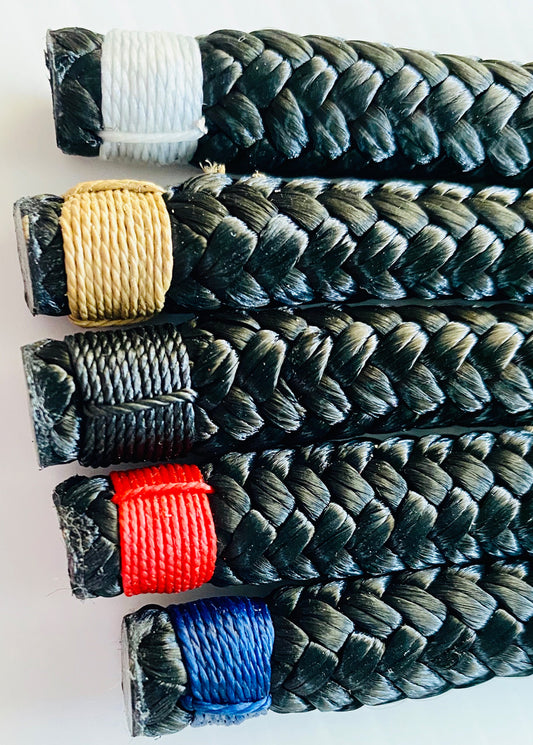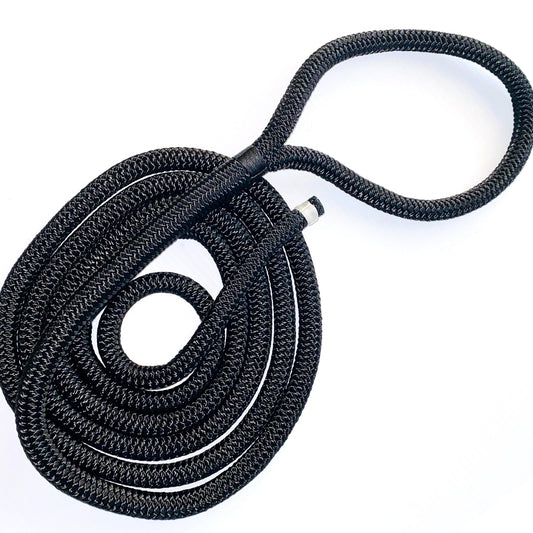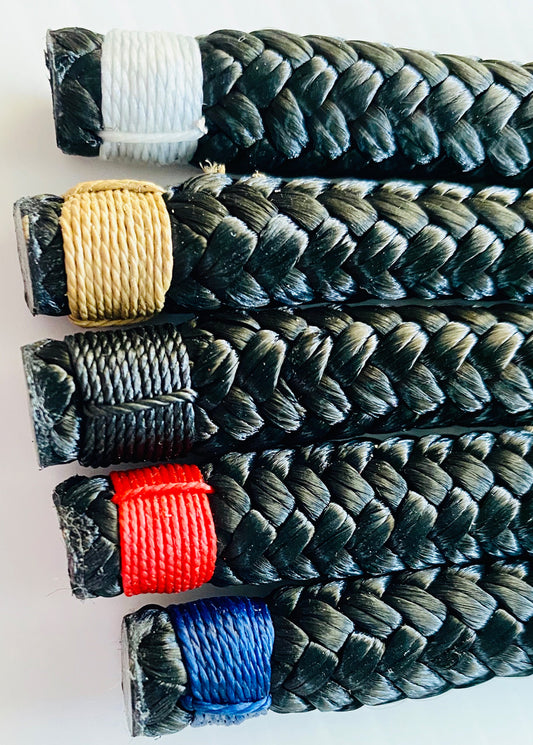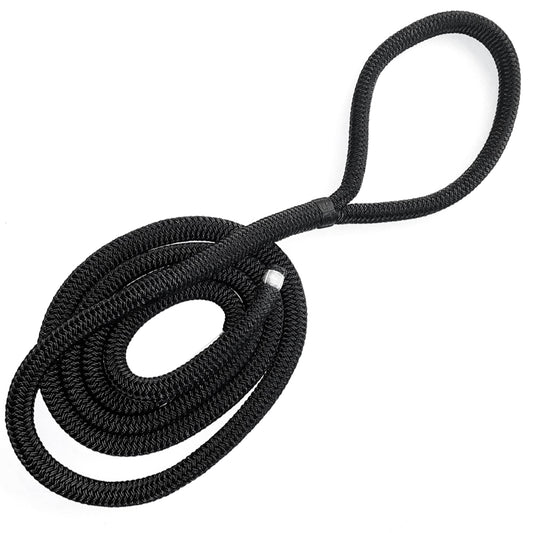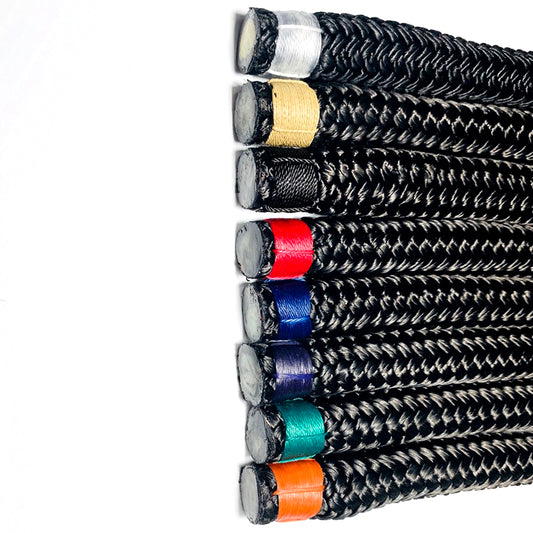WHY IS NYLON DOUBLE BRAID ROPE CONSTRUCTION SUPERIOR TO OTHER FORMS OF NYLON ROPE CONSTRUCTION ?
There are 2 main reasons Double Braid is superior to other forms of rope construction and I will address them separately.
CONSTRUCTION
There are four primary forms of rope construction: 3 strand, 8 strand, 12 strand or 12 plait and double braid.
There are other construction methods that I am not including but those are lines that cannot be spliced. Splicing is the most efficient means of putting an eye on the end of a line as opposed to tying a knot or bend in the line to form an eye. Splicing, if done correctly, will not reduce the tensile strength of the line while various knots and bends will reduce the strength by as much as 30 to 40%.
To make nylon rope , we start with a single extruded nylon fiber. This single fiber is then added to a lot of other fibers and twisted together in an “S” twist to form an “S” strand. You might want to think of this as a right hand twist. The number of fibers and the final diameter of this particular strand would be appropriate to the final size of the required rope. The quality and strength of the strand is proportional to the number of twists. The more twists there are, the more fiber is required and hence the more fiber, the stronger the strand.
3 Strand Rope Construction. 3 Strand rope is made by twisting 3 “S” strands together with a “Z” twist. This is in the opposite direction and may be thought of as a left hand twist. The two opposing twists, The “S” and the “Z” strand work together to keep the rope together and give it flexibility. Just like with twisting the strands, the more twists there are in the rope the stronger it is. Also, the more twists there are the harder the rope. Hence the term hard lay and soft lay rope. Because of the nature of this form of construction, if you look at a cross section of 3 strand you will see the 3 individual strands but can also note the are gaps or voids between the strands. These gaps or voids limit how much fiber can be in any given diameter. The fiber gives the rope its strength, the gaps restrict its strength. 3 strand rope is the oldest form of rope construction.
8 Strand Rope construction. As the term implies , 8 strand rope is made up of 8 strand. Unlike 3 strand which is a twisted / laid rope : 8 strand is a braided rope. Also unlike 3 strand which consists of 3 “S” strands: 8 strand consists of 4 “S” strand and 4 “Z” strands. The 4 “S” strands are made into 2 pairs as are the 4 “Z” strands . The pairs are then braided together , each alternating in opposing directions. And again, the opposing twists are what gives flexibility to the rope instead of it wanting to just coil. The improvement that this construction method has over 3 strand is that it allows for a bit more fiber and a little less gap, hence a stronger rope. 8 strand was the next to come into the market and is also sometimes referred to as square rope.
12 Strand or 12 Plait construction. 12 strand truly is just an improvement on 8 strand. It has 6 “S” strands and 6 “Z” strands. These are individually braided, not paired and for a line that is more round and not square. Again, this technological improvement lead to a bit more fiber and a bit less gap . hence a stronger line.
Double braid. Double braid, as term implies, consists of a braid core covered with a braided cover / Sheath. The core consists of an equal number of pairs, typically, of “S” strands and “Z” strands braided together. And the cover likewise. And just like the 8 and 12 strand lines, double braid utilizes the “S” twist versus the “Z” twist to give the line flexibility without it coiling in one direction. By reducing the size of the individual strands but massively increasing the quantity of the number of strands; the gaps have been reduced and the amount of fiber has been increased. So again, this technological improvement has increased the strength of double braid .
One of the bits of information that is required, by the Cordage Institute, on cordage spec sheets is the weight of a given size of rope for 100 feet. If you examine : 3 strand, 8 strand , 12 strand and double braid: you will note that in that order the tensile strength increases. 8 strand is stronger than 3. 12 is stronger than 8. And double braid is stronger than 12. The same for the weight of a hundred feet of line. Hence the lines are stronger because there is more fiber. Conclusion is double braid is stronger.
COLOR
The color of Nylon rope is a consideration. Nylon fiber comes out of the factory white. In order to dye the fiber to any any color, it goes through a laundry process. This process reduces the tensile strength 15 to 20%. If you look at a cross section of : 3 strand twist, 8 strand braid or 12 plait : if the rope is white , then all of the fiber is white. If the rope is black, then all the fiber is black. So the tensile strength of the black rope will be 15 to 20% less than that od the white rope. When you are looking at small diameter rope, this might not be significant. However as the diameter grows, the difference becomes significant.
It you look at a cross section of double braid, you will note that only the cover is black or whatever the color. The core is white. Generally across all sizes; the core accounts for about 60% of the fiber and the cover about 40% of the fiber. So if you are looking at colored lines for your vessel, double braid will be stronger.
